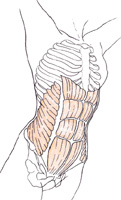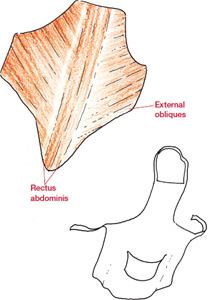 It All Starts with the Abdominals
It All Starts with the Abdominals
 The Gym Isn’t the Only Place to Work Your Abdominals
The Gym Isn’t the Only Place to Work Your Abdominals
It All Starts with the Abdominals
At birth, the newborn forcefully contracts his abdominals to push out the cry that signals his arrival into the world. And it was his mother’s superhuman abdominal contractions that propelled the infant into this realm just moments earlier.
Those very same abdominal muscles are involved with every emotion we feel. We contract them when we cry, when we’re angry, and when we’re afraid. They’re there every time we speak, and with every breath we take. As they relax and contract, they influence the movement and health of our organs. They initiate or follow the movements of our torso. They also stabilize the trunk to allow more range of motion for our arms and legs.
The Gym Isn’t the Only Place to Work Your Abdominals
Almost every activity works the abdominals to some degree. For example . . .
- Singing or public speaking demands intense abdominal work, as the abdominals must constantly vary their force in order for the voice to achieve range and intensity.
- Movement practices such as tai chi and qigong require a constant play of the limbs in a standing position. The abdominals are active here not just to keep the trunk vertical but also, and perhaps even more importantly, to hold the organs in place.
- Holding the myriad yoga positions calls for abdominal support.
- Doing a session of push-ups requires the abdominals to stabilize the trunk and prevent the belly from pooching.
- Dancing calls on the abdominals to fix or mobilize the pelvis.
- Even in a period of relaxation, when the abdominals don’t actively contract, abdominal work takes place. You must know the nature of “decontraction” to know the contracted state.
The Abdominals and Abdomen
The Abdominals
The abdominals are a group of four pairs of flat muscles that wrap a portion of the abdomen (the belly).

You can see that the abdominals form something like a chef’s apron that wraps the front and sides of the trunk.
The first is the rectus abdominis, found at the front of the belly. (This is the muscle that yields what’s commonly called “six-pack” abs.)
The other three, found on each side of the waist, are the transversus abdominis and the internal and external obliques. Together they form an overlapping muscle sheath three layers deep.

Working the Abs
“Working the abs” means performing exercises that reinforce the abdominal muscles.
The abdomen is the area that houses the viscera found below the diaphragm in the abdominal cavity. Above the diaphragm is the thoracic cavity.
The Abdominals Play a Double Role
1 • The Skeletal Role
The abdominal muscles attach to several bones of the trunk: the ribs, the sternum, the vertebrae, and the pelvis. They can therefore mobilize these bones. This is their skeletal role.
For example, we can see below how the abdominals bring the trunk into flexion, moving the pelvis closer to the sternum.

Without abdominals

With abdominals
2 • The Visceral Role
The abdominals make up a part of the envelope that encases the viscera of the abdomen, known as the abdominal sheath. When the abdominals contract, they can move the viscera, hold the viscera in place, or change their shape—a bit like a toothpaste tube. This is their visceral role.
For example, here we see how the abdominals can pull the belly in without any movement of the trunk.

Without abdominals

With abdominals
These two roles, skeletal and visceral, are often in play at the same time during a movement, making it difficult to analyze the movement’s effects. For this reason, in the exercises in this book we will always indicate whether the role of the abdominals is skeletal or visceral.
The abdominal cavity is the entirety of the “container” that holds the viscera of the abdomen. Though it’s often wrongly thought to be just the abdominal muscles, this cavity is made up of bony regions as well as muscles.

The abdomen houses the viscera below the diaphragm.
The word container isn’t quite accurate, as it brings to mind something rigid, like a box. The abdominal cavity is in fact very flexible—and flexible in every direction—not just because it’s made up in part of muscles, but because the bones that help make it up contain many joints:
- There are the joints between the vertebrae
- There are numerous joints in the rib cage
In addition, the ribs themselves, which are intricately related to the abs, can open or close to some degree, especially the lower ribs.

The abdominal cavity is a flexible container.